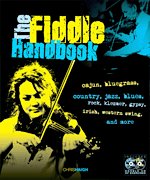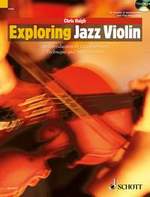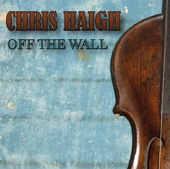
MENU TO FIDDLE STYLES:
BLUEGRASS VS WESTERN SWING
Two of the most fascinating and challenging forms of music to appear in 20thC America were bluegrass and western swing. Both developed at around the same time- the 1930’s and 40’s. Both were modern, forward looking and highly specialised branches of country music, and both had the fiddle at the core of the band. One went on to grow exponentially, with today thousands of bands all over the world, while the other, having boomed in its heyday, is now all but unknown. In this article I will compare the development of the two styles, and try to discover why one succeeded and the other failed.
Western swing was born in Texas in the 1930’s with the formation of a band called the Light Crust Doughboys, which later split into two other bands; Milton Brown and his Musical Brownies, and Bob Wills and his Texas Playboys. The starting point for western swing was the “ranchdance” style of country music, based around fiddle and guitar, playing old songs and instrumentals such as Liberty, Stone’s Rag, The Girl I left Behind me and Red River Valley. In an attempt to broaden the appeal of the music to the widest possible audience, Milton Brown and Bob Wills began to incorporate elements of swing jazz, then the height of sophistication in popular music, and to add more and more instruments. Drums, twin fiddles, the newly invented electric steel guitar, and a brass section were all part of the mix; by the time Wills made his first recordings for Brunswick in 1935, they were a 14-piece band. Wills was himself a fiddle player, but his was a very traditional Texan style. One of the great novelties of western swing was that he hired other fiddlers such as Jesse Ashlock and Joe Holly, who could play hot “take off” solos not unlike the jazz style of Joe Venuti or Stephane Grappelli. The western swing bands created a big sound, tightly arranged but with a lot of improvisation. It was loud, swinging music and aimed primarily at dancers.
Now let’s take a look at bluegrass. This grew out of what is variously described as hillbilly, old time, or Appalachian mountain music. Whilst western swing was mostly popular in Texas, the Midwest and California, bluegrass thrived east of the Mississippi, in the southern states such as West Virginia, north Carolina, Tennessee and Kentucky. The latter was the home of Bill Monroe, considered the Father of Bluegrass. Kentucky was known as the “blue grass State”, after a type of grass which grew there, and Monroe named his band Bill Monroe and his Blue Grass Boys. Monroe was a singer with a high tenor voice, and a mandolin player of unusual drive and velocity. He experimented with various combinations of stringed instruments until 1945, when he settled on the magic combination of Chubby Wise on fiddle, Lester Flatt on guitar, Earl Scruggs, a banjo player with a revolutionary new style, and Cedric Rainwater on double bass. Their style was firmly rooted in the traditional songs and tunes of Appalachia, but to this was added elements of blues and gospel . The energy, speed and instrumental virtuosity of the band made them an immediate hit at the Grand Ole Opry in Nashville ,Tennessee. This was a weekly radio show then, as now, at the heart of the country music establishment. The show was extremely conservative in outlook, and the Appalachian roots, the religious nature of many of the songs, and the fact that they all played acoustic instruments, made the Blue Grass boys a natural fit for the audience. The single appearance of Bob Wills, by contrast, was a struggle for all concerned. Drums and horns were then both considered way beyond the bounds of common decency within country music. Wills gave way on the horns, but at the last minute the band dragged out the drum kit from behind a curtain and performed their set as normal. The crowd loved it, but the management hated it and made sure they never came again.
Let’s compare the two styles as they stood in the mid 1940’s. Bob Wills was at the height of his fame, performing to audiences in their thousands who would come to dance to his music. He and his band had moved to California, performing to workers who had migrated en masse from Texas and the Midwest to work in the docks and munitions industries. There was a craze for western movies, and Wills and his band appeared in many of them, with titles such as The Last Horseman, Saddles and Sagebrush, and A Tornado in the Saddle. One of Wills’s songs, San Antonio Rose, was covered by Bing Crosby and sold well over a million copies. And Wills was by no means the only western swing bandleader. There were dozens, possibly hundreds of other bands playing in the same style, including most notably Spade Cooley, whose schmaltzy and over-the top performances frequently featured the remarkable sight of a harpist in a cowboy hat.
For Bill Monroe, meanwhile, not all was plain sailing. He was a hard and demanding taskmaster, and within a short time Flatt and Scruggs both left to form their own rival band, causing a rift which would last for decades. The departure of Scruggs was a particular blow, as his three finger style of banjo playing was one of the key features of the band’s sound, and one of its most popular features with audiences. Fiddler Chubby Wise also left, and for the next several decades, Monroe would have a constantly changing line up, though there was a constant supply of musicians able and willing to learn the particular demands of the style. Monroe’s records sold well, and he kept his place at the Opry, though his music remained a relatively minor branch of country music. Other rival bands such as the Stanley Brothers were also beginning to form, but compared to western swing, as a genre bluegrass had as a genre failed to take off at this stage.
The mid 1950’s was a period of crisis and rapid change for country music. The sudden appearance of rockabilly- the raw, energetic, amplified music targeted at teenage listeners, was a huge shock to the system. Sales and radio plays of country music plummeted, and Nashville record producers came up with a new formula, the “Nashville Sound”, designed to cross over to a mainstream audience. Smooth string sections and slick backing vocals were in, and fiddles were definitely out. Jim Reeves and Patsy Cline were the new stars, with a sound a million miles from either bluegrass or western swing.
For western swing the glory days were definitely over. The craze for westerns was over, and the modern American was more likely to watch television than to go out dancing on a Saturday night. The crippling federal “Cabaret Tax” of 1944 had seriously damaged the dance hall industry, which never really recovered. Bob Wills was able to continue playing but, as in the jazz world, his band size was drastically reduced. Spade Cooley, his chief rival, was doing time for murdering his wife. Many other bands either gave up or, like Bill Haley, jumped ship and became rock and rollers.
For bluegrass, the change in mainstream music was not such a threat. Elvis Presley, in particular, was proud to acknowledge his debt to the music of Bill Monroe, and recorded a rocked-up version of Monroe’s song Blue Moon of Kentucky. With a smaller band size, bluegrass was better able to cope with the economic stress of the times, and the fact that they mostly played for listening audiences meant that they did not suffer from the decline in dancing. The late 1950’s also saw an important new trend – the rise of the folksong movement. Alienated by mainstream popular music, but inspired by contemporary American folk singers like Woody Guthrie, many northern, educated young people developed an interest in grassroots acoustic music with American roots and a social conscience. This new audience discovered bluegrass, and were attracted to it because of its apparently ancient roots (even though strictly speaking bluegrass as such had only been around since the 1940’s). The exciting and demanding style of banjo was a particular draw, and, following the lead of Pete Seeger, many students began learning the instrument and avidly listening to the playing of Scruggs and others. It was at around this time that the separate words “Blue Grass” (as in Monroes’s band name) changed to “Bluegrass”, and was used as a term to describe not one band but a whole genre.
The folk movement, which became a major sponsor for the spreading of bluegrass, totally ignored western swing. With its drums, horns, electric guitars and steel, it would have been hard for anyone to sell the music to an audience wedded to the ideals of authentic, traditional and acoustic music. Western swing certainly had American roots, but it depended absolutely on its fusion with swing jazz- which at one time had been all the rage but by the 1950’s was itself dying a death.
The 1960’s and 70’s saw a continued rise in the fortunes of bluegrass. Open air bluegrass festivals spread across America, and dozens of new bands were formed. These included many veterans from the Monroe and Flatt & Scruggs bands, but also a host of young and extremely talented musicians with no country “pedigree” at all. A new branch of bluegrass sprang up, known variously as jazzgrass, newgrass, or new acoustic music. This continued the overall sound and instrumentation of bluegrass, but allowed much more complex and imaginative structures, chord sequences and more extended, jazzy soloing. Among fiddle players Vassar Clements, a veteran of the Blue Grass Boys, reinvented himself as the undisputed king of this type of fiddling, though many others- Richard Greene, Darrol Anger, Mark O’Connor and Sam Bush were all superb players. Bluegrass became a spectrum from the traditional (perhaps today best represented by the Del McCoury Band) to the progressive (The Punch Brothers). Bluegrass is also today closely wedded to the mainstream country music industry, and artists such as singer/fiddler Alison Krauss have had huge commercial and artistic success, particularly since the turning point of the Millennium, where the unexpectedly popular film Oh Brother Where art thou marked a turning point where country music, at least for the time being, turned its back on the pop crossover with which it had flirted since the late 50’s.
And what of western swing? On the downside, it is undoubtedly the looser in this bout. There are no western swing festivals that I know of. Compared to the several thousand bluegrass bands around the world, there are probably no more than a few dozen western swing bands worth the name. The fact that western swing requires amplification, drums, steel guitar and so on makes it a difficult prospect for anyone trying to get a band on its feet.
There have however been a series of successful Bob Wills tribute albums by country music stars including firstly Ray Price in 1961, followed by George Jones and Merle Haggard. Willie Nelson and George Strait have also helped to keep the spirit of western swing alive. The fiddler featured on most of these albums was Johnny Gimble. A veteran of the Bob Wills band, he brought western swing fiddling to its highest peak, effortlessly combining the roles of Texan fiddler and swing improviser, mastering the most dazzling double stops and startling harmonic adventures. He left very few recordings under his own name, but was always the first call for country singer who wanted authentic western swing fiddle.
And where can you hear western swing today? Fortunately there is one band, who have definitely kept the flame burning, and that is Asleep at the Wheel. Formed in 1979 by singer Ray Benson, the band was from the start allied to the counterculture, and played to rock rather than country audiences. With nine Grammy awards and a long string of successful albums, this is a band which has without any compromise managed to bring western swing safely into the 21st century. Finally, one other band needs to be mentioned. The Time Jumpers are a large and fluid group of top country session musicians who spend most of their time either in the studio or on the road with America’s top country singers. For fun, they play at a residency at the Station Inn in Nashville, with fiddlers Kenny Sears, Joe Spivey and Larry Franklin among their number. They have nothing to prove and no one to tell them what to play. They play western swing!
This article first appeared in Living Tradition magazine


